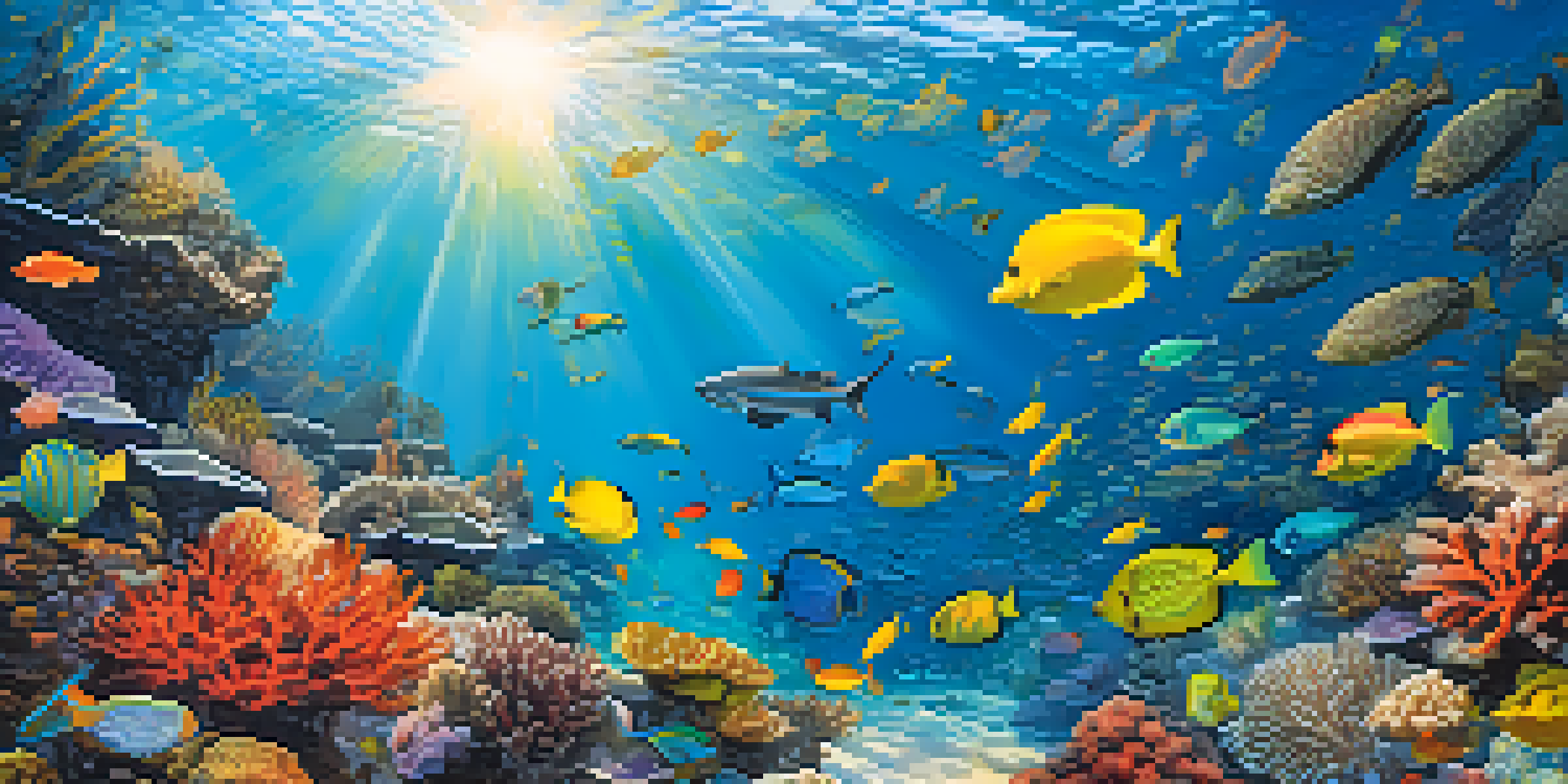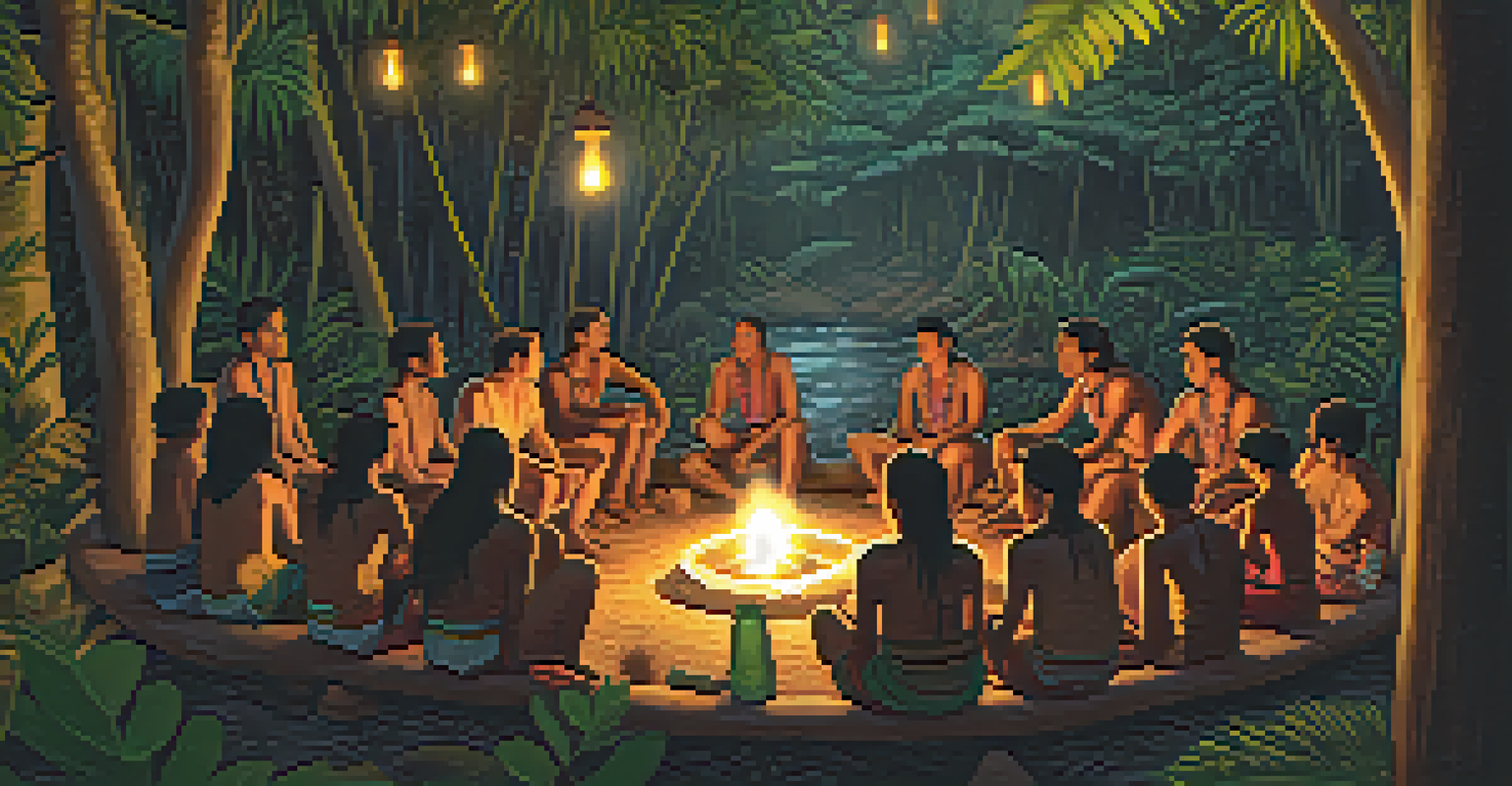Biodiversity Loss and Ayahuasca: A Call for Responsible Use

Understanding Biodiversity and Its Importance
Biodiversity refers to the variety of life on Earth, encompassing different species, ecosystems, and genetic diversity. It's essential for maintaining the balance of our ecosystems, providing services like clean air, water, and food. When biodiversity is lost, the effects ripple through the environment, impacting everything from climate stability to human health.
The greatest threat to our planet is the belief that someone else will save it.
Consider a vibrant coral reef teeming with life. Each species, from the tiniest plankton to the largest fish, plays a role in the ecosystem's health. If one species disappears, it can lead to a domino effect, disrupting the entire system. This example illustrates why preserving biodiversity is crucial, not just for the planet but for our survival.
Unfortunately, biodiversity is under threat from various factors, including habitat destruction, climate change, and overexploitation of resources. Awareness of these issues is growing, but we must also consider how our actions—like the use of ayahuasca—can impact the natural world.
What is Ayahuasca and Its Cultural Significance?
Ayahuasca is a traditional Amazonian brew made from the Banisteriopsis caapi vine and the Psychotria viridis leaf, known for its psychoactive properties. Indigenous tribes have used this sacred drink for centuries in spiritual and healing rituals, often to connect with nature and their ancestors. It's a profound experience for many, offering insights and a sense of community.

The use of ayahuasca is deeply rooted in the cultural practices of various Amazonian communities, where it's viewed as a tool for healing both individuals and the collective spirit. It’s not just a beverage; it’s a bridge to understanding one’s place in the universe, fostering respect for nature and all its inhabitants.
Biodiversity is Essential for Life
Maintaining biodiversity is crucial for ecosystem balance, providing essential services like clean air, water, and food.
However, as ayahuasca gains popularity outside its traditional context, it's essential to recognize and respect its cultural significance. Misusing or commodifying it can lead to a disconnect from the very values that have sustained its use for generations.
The Impact of Ayahuasca Harvesting on Biodiversity
The rising demand for ayahuasca has led to increased harvesting of its key ingredients, particularly the Banisteriopsis caapi vine. This overharvesting poses a significant threat to the natural ecosystems where these plants grow, often leading to habitat destruction and loss of biodiversity. As these plants become scarcer, the delicate balance of the forest ecosystems is disrupted.
In every walk with nature, one receives far more than he seeks.
Imagine a forest where the vibrant colors of life are slowly fading, and the sounds of wildlife diminish. This is the reality in many areas where ayahuasca is harvested unsustainably. The consequences extend beyond the immediate environment, affecting local communities that rely on these ecosystems for their livelihood and cultural practices.
To mitigate these impacts, it's crucial to adopt sustainable harvesting practices that respect the natural environment. By ensuring that ayahuasca is sourced responsibly, we can help protect biodiversity while still honoring its cultural significance.
Responsible Use: A Path to Sustainability
Responsible use of ayahuasca means prioritizing sustainability and the wellbeing of the environment. This involves sourcing ingredients from suppliers who practice ethical harvesting and support reforestation efforts. By doing so, we can ensure that the ecosystems that produce these plants remain healthy and vibrant.
Consider supporting ayahuasca retreats that emphasize environmental stewardship and educate participants about the ecological impact of their consumption. It’s not just about the experience; it’s about contributing positively to the communities and ecosystems involved in the process.
Ayahuasca Harvesting Threatens Nature
The rising demand for ayahuasca leads to unsustainable harvesting practices, threatening the ecosystems that support its key ingredients.
By making informed choices, we can enjoy the benefits of ayahuasca while also playing a role in conserving biodiversity. This balance is essential for the future of both ayahuasca and the natural world it comes from.
The Role of Education in Conservation Efforts
Education plays a vital role in promoting responsible use of ayahuasca and raising awareness about biodiversity loss. By informing consumers about the environmental impacts of their choices, we empower them to make decisions that support sustainability. Workshops, documentaries, and community outreach programs can be effective tools in this effort.
For instance, learning about the traditional practices of indigenous communities can foster a deeper appreciation for the cultural significance of ayahuasca and its ingredients. This understanding can inspire individuals to engage in conservation efforts, both in their local communities and globally.
Moreover, as more people become educated about the interconnectedness of ayahuasca use and biodiversity, they are more likely to advocate for sustainable practices. This collective effort can lead to significant positive changes in how we approach both ayahuasca consumption and environmental conservation.
Community Involvement: A Collective Responsibility
Community involvement is crucial in addressing the challenges posed by biodiversity loss and ayahuasca use. Local communities, especially those in the Amazon, have invaluable knowledge about sustainable practices and the importance of biodiversity. Engaging these communities in conservation efforts not only benefits the ecosystems but also acknowledges their rights and expertise.
Collaborative projects that involve local populations in the sustainable harvesting of ayahuasca can create economic opportunities while preserving their cultural heritage. For example, community-run ayahuasca retreats can provide income and promote responsible tourism, ensuring that profits support local conservation initiatives.
Education and Community Matter
Promoting education and involving local communities in conservation efforts are vital for protecting biodiversity and ensuring sustainable ayahuasca use.
We all share the responsibility of protecting our planet. By supporting these community-led efforts, we can help maintain biodiversity and promote a more sustainable future for ayahuasca and its associated ecosystems.
A Call to Action: Protecting Our Biodiversity
As consumers of ayahuasca, we have the power to influence the future of biodiversity. It’s essential to support initiatives that promote sustainable harvesting and educate others about the importance of biodiversity. By making conscious choices, we can contribute to the preservation of these vital ecosystems.
Consider participating in or supporting organizations that focus on rainforest conservation and sustainable practices related to ayahuasca. Every small action counts, whether it’s donating, volunteering, or simply spreading awareness about the issues at hand.

The call to action is clear: let’s be responsible stewards of the Earth. By protecting biodiversity, we ensure a healthier planet for future generations, and we honor the cultural heritage of ayahuasca that connects us all.